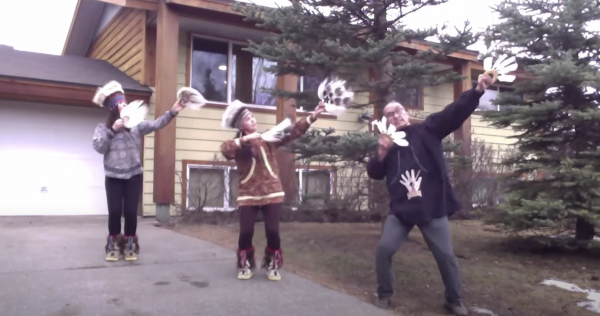
Gabby Hiestand-Salgado, a Jesuit Volunteer working at KYUK, came up with the idea of making a film of people dancing to the same Yup’ik song from wherever they were hunkering down during the pandemic. The two Blanchett brothers, Phillip and Steven, and their band, Pamyua, were quick to help.
The chosen song, Tarvarnauramken, is a traditional blessing song Pamyua recorded on their album “Drums of the North.”
The role of dance and music in healing stretches back through time. Marie Meade, a humanities professor and Phillip and Steven’s mother, says that the song is an ancient blessing and purification ritual with many versions. The version on the video has two verses. Both are about the use of a traditional herb called Ayuq, also known as Labrador, or Tundra Tea.
“First verse talks about using the healing powers of the Ayuq for hunters before they go out into the ocean that we all know is very powerful. The second verse talks about using the Ayuq tea medicine to purify bodies and ourselves before we go out on the land to gather plants and berries,” Meade said.
RELATED: A Chilkat mask remembers how ‘we took care of each other’ during the pandemic
The performance is a collaboration. People sent videos of themselves dancing to the song while practicing social distancing. Salgado edited them together, which was not easy. Dancing alone is not the Yup’ik way, which would normally be people gathering together to drum, sing, and dance. The energy from the group carries the song. Phillip Blanchett said that it was hard to dance along with a song the band had recorded before COVID-19 appeared on the planet. He closed his eyes, and it helped.
“That’s what I was trying to connect to: all of my memories of dancing the song and learning it, and thinking about the intention of the song. That’s what grounds me when I dance,” Blanchett said.
When the final video was put on Facebook, YouTube, and the KYUK website, the response was overwhelming. From all over the world, people wrote comments indicating a need and gratitude for healing, blessing, and purification. It is amazing to think that a song composed in the Yukon-Kuskokwim Delta centuries ago was playing in New Zealand, New York, Scotland, and more. One woman wrote: “I am from Paris, France, sending my respect and heart energy. Even through distance, we are connected. Your music has been playing in my yard. The drums resonate in the sky.”
“There’s so much enormous trauma that we’re still in shock of what’s happening globally. To me, that to be able to find things that have strength and have that power within it, that intention for cleansing and for embracing things that we see as good, the song itself and the dancing is something other people can feel and recognize,” Blanchett said.
Meade also dances in the video. She said that Yup’ik people have a special heritage to offer the world. Not only did they survive pandemics in the past, but they kept the culture alive. She advises doing what was done before.
“Just share what is good to help one another. Just stay, and that’s what our ancestors did for us. So here we are today going through the same thing, and we can do the same thing,” Meade said.
Watch the video here.
Pamyua credits Brentina Papangluaq Chanar as the composer of Tarvarnauramken. Stephen Blanchett and Phillip Blanchett learned the song from Brentina’s son David Chanar. David was one of the drum leaders for the Anchorage-based dance group Kicaput, which Stephen and Phillip were members of. Pamyua was granted permission to record the song from David Chanar and his siblings.




